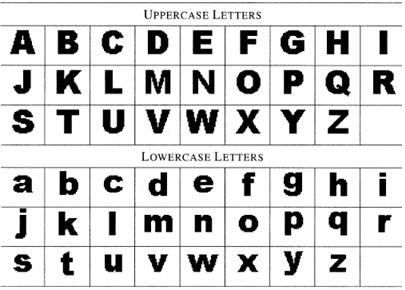The Alphabet
Content
In English, like in Spanish, the alphabet has 26 letters:
A B C D E F G H I J K L M N O P Q R S T U V W X Y Z
Let’s discover their names and how to say them in English. Click on the following link:
You can also click on the following audio file to listen to the pronunciation of the letters:
Remember that this is how we say the name of each letter. When we combine these letters into words, they often have a different sound. You will understand this concept as you progress through the course.
To remember how to pronounce the letters, listen to this next song and try to learn it by memory:
As in Spanish, the English alphabet has both vowels and consonants:
– 5 of the letters in the English Alphabet are vowels: A, E, I, O, U.
– The remaining 21 letters are consonants: B, C, D, F, G, H, J, K, L, M, N, P, Q, R, S, T, V, W, X, Y, and Z.
Finally, the big letters are called “uppercase” or “capital” letters, and the small letters are called “lowercase” letters.

Practice Zone
In the following link, you will find a game to practice what you have learned about the alphabet in this lesson. Once on the game website, begin by clicking on “Ready” and try to get a Gold Medal!
Click here to access the Alphabet Game
Numbers
HeyGen Introduction Video
Content
We will begin with the easy numbers, 1 to 10. Their names are:

Now, let’s look at the names of the numbers 11 to 20.

Next, let’s revise other numbers that, like 20, end in zero. These numbers have “-ty” at the end of their names.

The numbers in this group, including 20, are called “tens” because they are multiples of ten.
What about all the other numbers after 20 that aren’t “tens”, such as 21 or 35? Well, for these you need to use the format “tens + ones”. For example:
- 21 = “twenty-one” (20 + 1)
- 35 = “thirty-five” (30 + 5)
- 46 = “forty-six” (40 + 6)
- 52 = fifty-two” (50 + 2)
- 68 = “sixty-eight” (60 + 8)
- 74 = “seventy-four” (70 + 4)
- 83 = “eighty-three” (80 + 3)
- 99 = “ninety-nine” (90 + 9)
Finally, we have 0 = “zero” and 100 = “one hundred”. These two are also very important numbers.
Now that you know all these numbers, how can you say them correctly? Click on the link below to go to a website that will help you. Once you’re on the website, put your mouse over any number to hear its pronunciation:
Click here: Interactive Numbers Pronunciation
Additionally, the next video uses a song to help you remember how to say the numbers we have revised, along with a few extra ones.
Ordinal numbers
Ordinal numbers are used to indicate a position or rank. Here is an image showing the first twenty in blue:

As you can see, the “normal” numbers are known as CARDINAL numbers.
Decimals
To say decimals in English, you need to pronounce the decimal point as “point”, and read each digit individually. If the number before the decimal is “0,” you can decide not to mention it.

Fractions
We say fractions by reading the number on top first, and then saying the bottom number as an ordinal (like first, second, etc.). For example: 1/5 = one fifth
If the number in the top is greater than 1, then we say the ordinal in the bottom in plural. For example: 3/5 = three fifths
A special case is the number 2, which is read “half” when it is the bottom, and “halves” if there is more than one. Examples: 1/2 = one half ; 5/2 = five halves.

Practice Zone
Explanation of activities
